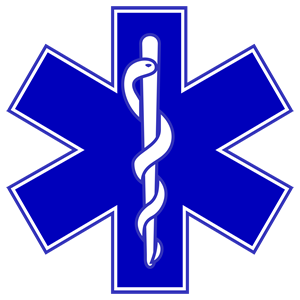Lesson 4: Emergency Response Procedures
Attention

"Star of Life" symbol for Emergency Response Teams
Learning Outcomes
Upon completion of this lesson's material, students will be able
- Demonstrate knowledge of emergency procedure requirements for licensed facilities in Maine
- Discuss appropriate actions and responses when dealing with emergency situations
Teaching
Read Chpt 5 SN &H
Teachers need to be prepared for emergency situations. All facilities should have an emergency response plan that addresses:
• medical emergencies
• evacuation procedures
• lock down situations
• natural disasters
• fire
• missing children
Emergency information should be stored in a convenient place where it can be quickly accessed, along with an emergency supply kit. Practice drills for both evacuation and lock down situations should be conducted regularly. In Maine, licensed facilities are required to be inspected by the Fire Marshal on a regular basis, have working smoke detectors and practice fire drills. Staff is responsible for recording these drills to report to the licensing agent. Maine Child Care Licensing rules require at least one First Aid/CPR certified staff member to be on-site at all times. It is a good idea for all staff to have this certification.
Drills as well as real emergencies can be emotionally upsetting to children. Caregivers need to be calm, prepared and supportive of distressed children. Pre-drill discussions and activities can help alleviate some anxiety and follow up conversations are important in order to reassure the students.
It can be helpful to have firemen visit your students during the year.
When in full gear, firefighters can seem frightening to young children during an emergency situation. Sometimes children will hide during a fire, and we want them to feel safe to be rescued. Most local personnel will gladly come to your center to visit. Many of them will show the children each piece of equipment that he/she wears and discuss why they wear it. This lets the kids know that there is a real person inside of the uniform. They may also talk about “Stop, Drop and Roll” procedures or bring smoke houses to practice an evacuation. You need to know what is appropriate for your young students and what they can handle. You should always inform parents before the visit. It’s also a good idea to invite parents to participate in this event.
Another option is an ambulance visit. If you cannot transport children to the local hospital for a tour, you could ask the ambulance service to come to you. Children enjoy learning while also understanding that the ambulance and hospital services are there to make them feel safe. This can help alleviate some stress for children if they need to be transported by ambulance or stay in the hospital. This is another great opportunity to invite and connect with families.
Follow this up by setting up your dramatic play area with firefighter clothing or hospital materials & uniforms. Children process what they learn by recreating events and using their imaginations. It is also the perfect opportunity for you to have follow up conversations with them as they role play these situations. And don’t forget to put out books about hospitals, doctors, ambulances and firefighters throughout your room.
Assessment
Lesson 4 Quiz
Lesson Quizzes will consist of material from the lesson, the discussions, and from assigned reading. Questions will be True/False, Multiple Choice, and Short Answer. Be sure to review all the Lesson and Reading material prior to starting this quiz.
Lesson 4 Discussion
Describe an emergency situation you have dealt with. How was it handled? What could have been improved upon? What went well? What advice would you give your classmates about handling an emergency situation in a child care center?